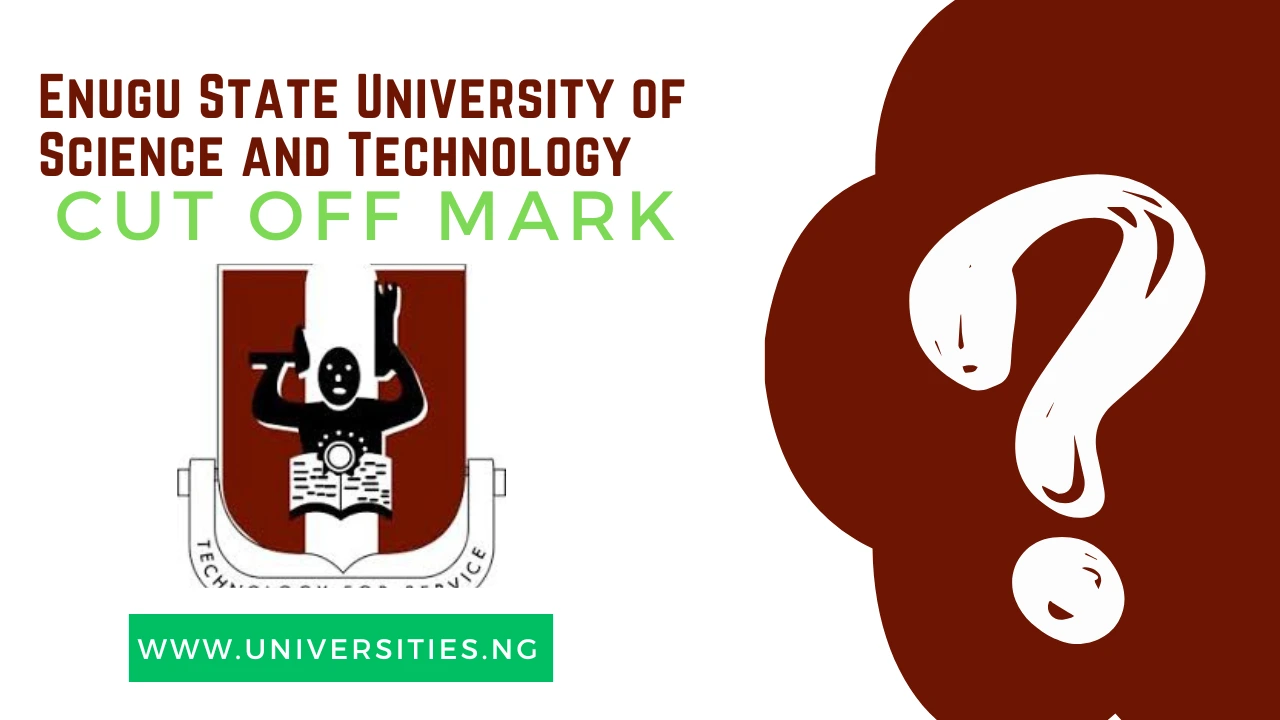Enugu State University of Science and Technology (ESUT) is one of Nigeria’s top universities, and thousands of applicants come in every year. Just like all the universities, ESUT also has a Cut off mark to determine which candidates are qualified for admission.
The Cut off mark is a deciding factor in the admission process. It helps the university screen candidates based on academic performance and space availability. Scoring or exceeding the required mark enhances students’ opportunities to secure admission. Failure to meet the mark, however, could lead to applying for another course or reapplying in the next admission cycle.
This article has the full information regarding ESUT’s Cut off marks, including requirements for specific courses, how the university determines these marks, and what to do if a candidate doesn’t meet the requirements. If you are a prospective student or a parent guiding your ward, this article will give you all the information needed to understand ESUT’s admission process.
What Is a Cut off Mark?
The Cut off mark is the minimum score a student must obtain to gain entry into a university. The Joint Admissions and Matriculation Board (JAMB) sets the overall standard, but each university may alter it to fit its admissions policy.

Why Is It Important?
- It ensures only qualifying students gain admission.
- It helps the universities to regulate the massive applicants.
- It facilitates level playing among applicants.
For the ongoing 2025/2026 admission , the ESUT Cut off mark is 160. That is to say, those candidates who score 160 and above in JAMB are qualified to proceed to the next phase: post-UTME screening.
ESUT Cut Off Mark for All Courses
The table below shows ESUT’s Cut off marks for various courses:
Course | Cut-Off Mark | Note |
|---|---|---|
Medicine and Surgery | 200 | Highly competitive; requires excellent UTME and O’Level results. |
Medical Laboratory Science | 200 | Competitive; strong science background essential. |
Nursing Sciences | 200 | High demand; prioritize candidates with top scores. |
Pharmacy | 200 | Science-intensive; limited slots available. |
Law | 200 | Requires high UTME scores and strong O’Level grades. |
Anatomy | 160 | Foundational course for medical sciences. |
Agricultural Economics & Extension | 160 | Focuses on agricultural policies and economic principles. |
Agronomy and Ecological Management | 160 | Emphasizes sustainable farming practices. |
Animal Science and Fisheries Management | 160 | Combines animal husbandry and aquatic resource management. |
Food Science and Technology | 160 | Integrates food processing and preservation techniques. |
Applied Biochemistry | 160 | Studies chemical processes within and related to living organisms. |
Applied Biology | 160 | Broad exploration of biological systems and organisms. |
Applied Microbiology | 160 | Focuses on microorganisms and their applications. |
Computer Science | 160 | Covers programming, algorithms, and system design. |
Geology and Mining | 160 | Studies earth materials and mining techniques. |
Industrial Chemistry | 160 | Applies chemical principles to industrial processes. |
Industrial Mathematics and Statistics | 160 | Emphasizes mathematical modeling and statistical analysis. |
Industrial Physics | 160 | Applies physics concepts to industrial applications. |
Adult Education | 160 | Prepares educators for adult learning environments. |
Agricultural Education | 160 | Trains educators in agricultural sciences. |
Business Education | 160 | Combines business principles with teaching methodologies. |
Computer Education | 160 | Focuses on teaching computer literacy and applications. |
Education Administration and Supervision | 160 | Prepares for leadership roles in educational settings. |
Education Biology | 160 | Trains biology educators for secondary schools. |
Education Chemistry | 160 | Prepares chemistry teachers for academic institutions. |
Education Management | 160 | Focuses on managing educational institutions and policies. |
Education Mathematics | 160 | Trains mathematics educators for various levels. |
Education Physics | 160 | Prepares physics teachers for academic roles. |
Educational Foundation | 160 | Studies the basics of educational theories and practices. |
Guidance and Counseling | 160 | Trains professionals to support student development. |
Human Kinetics | 160 | Focuses on physical education and sports science. |
Integrated Science Education | 160 | Prepares educators to teach integrated science subjects. |
Library and Information Science | 160 | Trains librarians and information managers. |
Technology and Vocational Education | 160 | Combines technical skills with teaching methodologies. |
Agricultural Engineering | 160 | Applies engineering principles to agriculture. |
Chemical Engineering | 160 | Focuses on chemical processes and equipment design. |
Civil Engineering | 160 | Deals with design and construction of infrastructure. |
Computer Engineering | 160 | Integrates computer science and electrical engineering. |
Electrical and Electronics Engineering | 160 | Covers electrical systems and electronic devices. |
Mechanical and Production Engineering | 160 | Focuses on machinery design and manufacturing processes. |
Metallurgical and Materials Engineering | 160 | Studies properties of metals and material science. |
Architecture | 160 | Combines art and science in building design. |
Building | 160 | Focuses on construction management and technology. |
Estate Management | 160 | Deals with property valuation and management. |
Geography and Meteorology | 160 | Studies earth’s landscapes and weather patterns. |
Quantity Surveying | 160 | Manages construction costs and contracts. |
Surveying and Geoinformatics | 160 | Involves mapping and spatial data analysis. |
Urban and Regional Planning | 160 | Focuses on the development of urban areas. |
Accountancy | 160 | Deals with financial reporting and auditing. |
Banking and Finance | 160 | Studies financial systems and banking operations. |
Business Administration | 160 | Covers management principles and business operations. |
Co-operative and Rural Development | 160 | Focuses on community development and cooperative management. |
Insurance and Risk Management | 160 | Deals with risk assessment and insurance principles. |
Marketing | 160 | Studies market research and consumer behavior. |
Economics | 160 | Analyzes production, distribution, and consumption of goods. |
English and Literary Studies | 160 | Explores English language and literature. |
Mass Communication | 160 | Covers journalism, media, and communication theories. |
Political Science | 160 | Studies government systems and political behavior. |
Psychology | 160 | Explores human behavior and mental processes. |
Public Administration | 160 | Focuses on government policies and administrative functions. |
Sociology | 160 | Studies social behavior and society structures. |
Pharmacy | 200 | Requires strong background in sciences; limited admission slots. |
Admission Process & Requirements
Admission into ESUT is a clearly an outlined process:
1. JAMB Registration & Examination
Candidates must register for JAMB and opt for ESUT as their first choice institution. They have a minimum cut off of 160.
2. Post-UTME Screening
Only those who pass according to the JAMB Cut off are asked to register for ESUT’s post-UTME screening, for which they take another test.
3. O’Level Requirements
Students must have at least five credits in Mathematics and English, as well as other relevant subjects to the course, in WAEC, NECO, or NABTEB.
4. Direct Entry (DE) Admission
Candidates with ND, HND, or A-level results may apply through direct entry for admission to 200-level.
5. Final Admission List
After screening, ESUT releases a merit list. In case of vacancies, supplementary lists may release.
Post-UTME Screening & Aggregate Score Calculation
Post-UTME Screening Process
- Register online via ESUT’s admission portal.
- Make payment of the screening fee as needed (usually around ₦2,000).
- Show necessary documents (JAMB result, O’Level result, birth certificate, etc.).
- Sit for the screening test.
How Aggregate Scores Are Calculated
ESUT combines JAMB scores and Post-UTME scores to get the final admission list. The formula is:
Aggregate Score = (JAMB Score ÷ 8) + (Post-UTME Score ÷ 2)
For example, where a candidate scores 200 in JAMB and 50 in Post-UTME:
- JAMB: 200 ÷ 8 = 25
- Post-UTME: 50 ÷ 2 = 25
- Total Aggregate Score = 50
A higher aggregate score increases opportunity for admission.
How ESUT Determines Its Cut off Mark
The factors that influence ESUT’s Cut off marks include:
- JAMB Cut off mark: JAMB fixes the general cut off mark to which the universities are supposed to stick.
- Departmental Competition: The departments with highly demanded courses like Law and Engineering get higher Cut off marks.
- Available Slots: Those departments that have fewer slot may raise their Cut off marks to manage admission numbers.
What To Do If You Don’t Meet the Cut off Mark
If you score below the Cut off mark in the post-UTME or JAMB, do these:
- Switch Course: Register for a less demanding course.
- Enroll in a Pre-Degree Programme: ESUT offers foundation courses that allow candidates to be accepted after one year.
- Retake Next Year: You can retake JAMB and boost your score.
- Transfer from a Different University: Having completed 100-level from a different university, apply for transfer admission.
Frequently Asked Questions (FAQs)
What is ESUT’s JAMB Cut off mark?
The general JAMB Cut off for ESUT is 160.
Can I gain admission with 150 in JAMB?
No, you need at least 160.
Does ESUT accept second-choice candidates?
No, ESUT only considers first-choice applicants.
What is the Cut off mark for Law at ESUT?
The Cut off mark for Law is 200.
How much is the post-UTME form?
The price is usually ₦2,000.
How is the aggregate score calculated?
JAMB score (divided by 8) + post-UTME score (divided by 2).
Can I apply for direct entry?
Yes, candidates with ND, HND, or A-Level can apply.
Does ESUT conduct post-UTME exams?
Yes, ESUT conducts a screening test.
Can I transfer to ESUT from another university?
Yes, ESUT accepts transfer students.
When does ESUT release the admission list?
Admission lists are released a few weeks after post-UTME.
Is ESUT a federal or state university?
ESUT is a state university.
What are the O’Level requirements?
At least five credits, including Mathematics and English.
Can I gain admission without post-UTME?
No, post-UTME is compulsory.
Does ESUT offer scholarships?
Yes, there are scholarships for high-performing students.
Where can I check ESUT admission updates?
Visit www.esut.edu.ng.
Conclusion
ESUT’s admission process requires candidates to meet the Cut off mark and perform well in post-UTME. If you meet the requirements, use the steps outlined here to secure your position. For official information, visit ESUT’s website. If you’ve found this article helpful, then share it with other candidates!









How can I write my post UTME exam
How can I login to ESUT portal